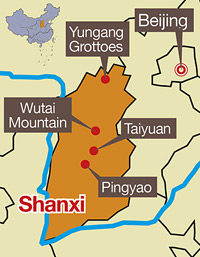|
Chinese Properties Inscribed on the World Heritage List Cultural
1. The Great Wall (Beijing, 1987)
2. Imperial palaces of the Ming and Qing dynasties in Beijing and Shenyang (the Forbidden City, Beijing, 1987; Imperial Palace of the Qing Dynasty, Shenyang, Liaoning Province, 2004)
3. Peking Man Site at Zhoukoudian (Beijing, 1987)
4. Mogao Caves (Gansu Province, 1987)
5. Mausoleum of the First Qin Emperor (Shaanxi Province, 1987)
6. Mountain resort and its outlying temples, Chengde (Hebei Province, 1994)
7. Historic ensemble of the Potala Palace, Lhasa (Tibet Autonomous Region, 1994)
8. Temple and cemetery of Confucius and the Kong Family Mansion in Qufu (Shandong Province, 1994)
9. Ancient building complex in the Wudang Mountain (Hubei Province, 1994)
10. Lushan National Park (Jiangxi Province, 1996)
11. Ancient city of Pingyao (Shanxi Province, 1997)
12. Classical gardens of Suzhou (Jiangsu Province, 1997)
13. Old town of Lijiang (Yunnan Province, 1997)
14. Summer Palace, an imperial garden in Beijing (Beijing, 1998)
15. Temple of Heaven, an imperial sacrificial altar in Beijing (Beijing, 1998)
16. Dazu Rock Carvings (Chongqing, 1999)
17.Imperial mausoleums of the Ming and Qing dynasties (Ming Xianling Mausoleum, Hubei Province, 2000; Qing Dongling Mausoleum and Qing Xiling Mausoleum, Hebei Province, 2000; Ming Tombs, Beijing, 2003; Ming Xiaoling Mausoleum, Jiangsu, 2003; three imperial mausoleums of Shengjing, Liaoning Province, 2004)
18. Longmen Grottoes (Henan Province, 2000)
19. The Qingcheng Mountain and the Dujiangyan Irrigation System (Sichuan Province, 2000)
20. Ancient villages in southern Anhui—Xidi and Hongcun (Anhui Province, 2000)
21. Yungang Grottoes (Shanxi Province, 2001)
22. Capital cities and tombs of the Ancient Koguryo Kingdom (Liaoning and Jilin provinces, 2004)
23. Historic center of Macao (Macao Special Administrative Region, 2005)
24. Yinxu (Henan Province, 2006)
25. Kaiping Diaolou and villages (Guangdong Province, 2007)
26. Fujian Tulou (Fujian Province, 2008)
27. Wutai Mountain (Shanxi Province, 2009)
Natural
28. Huanglong Scenic and Historic Interest Area (Sichuan Province, 1992)
29. Jiuzhaigou Valley Scenic and Historic Interest Area (Sichuan Province, 1992)
30. Wulingyuan Scenic and Historic Interest Area (Hunan Province, 1992)
31. Three Parallel Rivers of Yunnan Protected Areas (Yunnan Province, 2003)
32. Sichuan giant panda sanctuaries—Wolong, Siguniang Mountain and Jiajin Mountain (Sichuan Province, 2006)
33. South China Karst (Yunnan Province, Guizhou Province and Chongqing Municipality, 2007)
34. The Sanqing Mountain National Park (Jiangxi Province, 2008)
Mixed
35. Taishan Mountain (Shandong Province, 1987)
36. Huangshan Mountain (Anhui Province, 1990)
37. Emei Mountain Scenic Area, including Leshan Giant Buddha Scenic Area (Sichuan Province, 1996)
38. Wuyi Mountain (Fujian Province, 1999)
Sacred Buddhist Mountains in China
Wutai Mountain, Jiuhua Mountain, Emei Mountain and Putuo Mountain are seen as the four sacred buddhist mountains in China. Here is a brief introduction to the other three.
Located in central China's Anhui Province, Jiuhua Mountain covers an area of 120 square km. Its peak rises to 1,342 meters above sea level. During the golden periods of the Ming and Qing dynasties, there were 360 temples that held up to 5,000 monks and nuns. It is regarded as the most beautiful mountain among the four and is a famous pilgrimage location in central China.
Emei Mountain is in southwest China's Sichuan Province and is where China's first Buddhist temple was built in the first century. The patron bodhisattva of Emei is Samantabhadra, known in Chinese as Pu Xian. The Emei Mountain is also famous as one of the sources of Chinese martial arts, which flourished in the 16th and 17th centuries. The mountain was included on the World Heritage List in 1996.
Putuo Mountain, located in east China's Zhejiang Province, is the place where rites are held for the revered Avalokitesvara Bodhisattva, known as Guan Yin in Chinese. Religious activities at Putuo Mountain can be traced back to the Qin Dynasty (221-206 B.C.), when many Taoists searched for pills that imparted immortality.
Shanxi Province

North China's Shanxi Province, whose name means "the west of the mountain," has a population of more than 34 million. Shanxi's center is dotted with a series of valleys, while the Yellow River runs through the province from north to south and the Taihang Mountains create its eastern border. The Great Wall forms most of its northern boundary with Inner Mongolia Autonomous Region.
It is a leading coal producer in the country, with deposits containing 260 billion metric tons of the fossil fuel.
There are two other sites in the province included in the World Heritage List in addition to Wutai Mountain:
The ancient city of Pingyao has been included in the World Heritage List since 1997. Located near Taiyuan, it was once an important Chinese financial center in the Ming (1368-1644) and Qing (1644-1911) dynasties.
The Yungang Grottoes in the north of the province have been listed as a world heritage site since 2001. The grottoes, located in Datong, consist of 252 caves that contain 5th- and 6th-century Buddhist sculptures and reliefs. | 